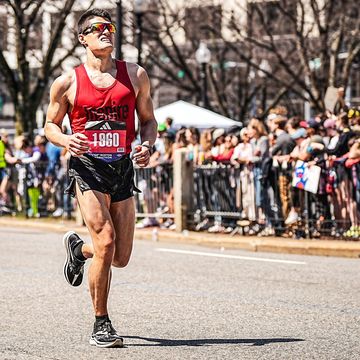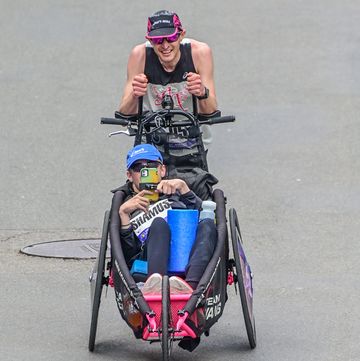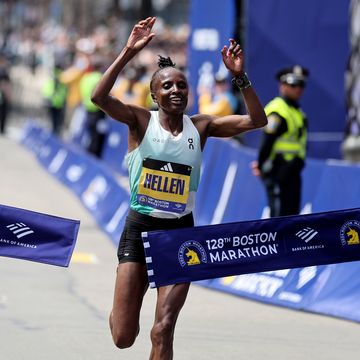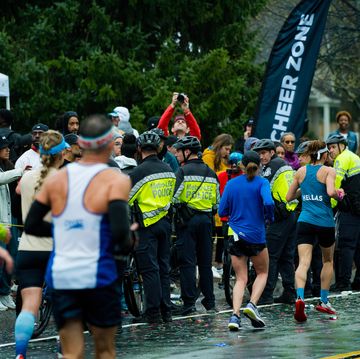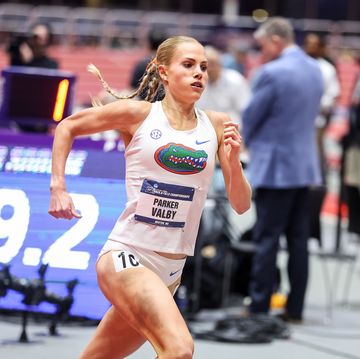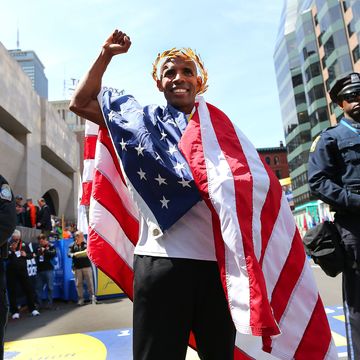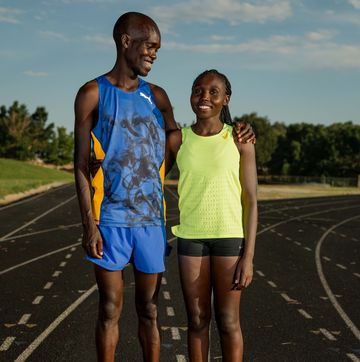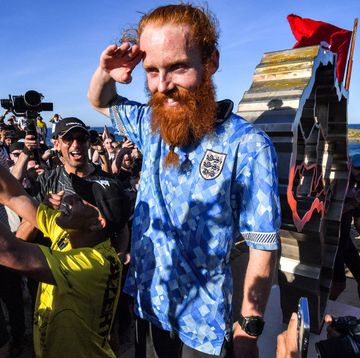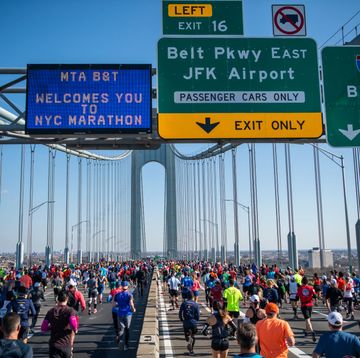I’m going to pull a tired trope, but I’m indeed old enough to remember when Brandi Chastain ripped her shirt off in celebration of her game-winning penalty kick to take the women’s World Cup soccer title for the United States in 1999. She was brought to her knees in jubilation, jersey in hand, wearing shorts, a sports bra, and nothing but elation on her face.
The iconic image landed on the covers of Sports Illustrated, Newsweek, and Time. And it felt like the tide was turning—the country was realizing, finally, that women’s sports could offer just as much thrilling competition and athleticism as men’s, and that women could elicit the same adulation for their athletic achievements. And they could do it all while baring their midriffs.
Alas, it’s nearly two decades later and not all has gone according to plan. We could cover many perplexing and frustrating societal examples, but for now, see Rowan University, circa 2018.
By now many already know the story, which was shared among runners on Friday. The women’s cross-country team at Rowan, located in Glassboro, New Jersey, was told by the athletic director that members weren’t allowed to practice in just sports bras—that according to an unwritten athletic department policy, they were required to wear shirts. Also, the women weren’t to use the track on campus at the same time the football team was practicing on the field.
A blog post by Gina Capone, a 21-year-old runner (training for the 2019 Boston Marathon) who attends Rowan and was on the team last year, described what members of her former squad told her: “Women running around the track in sports bras at their own practice were claimed to be distracting to the football players on the field during the same time.”
All requests to coaches and university officials for comment by Runner’s World were referred to Joe Cardona, vice president for university relations.
“I think the distraction is having another team there as you’re practicing,” Cardona said, disputing the story that the football players lost focus because women were doing their workout around a facility created for such a purpose, while wearing tops that are considered standard attire in the sport of track and field.
I spoke with Capone, Cardona, and Hannah Vendetta, a senior on the Rowan University cross-country and track team and came away with these thoughts:
Real policies are written down, not passed down like folklore.
As soon as Capone’s piece went viral, the university issued a statement describing a “verbal policy” the athletics department had held for an untold period of time that stipulated a dress code. It allegedly mandated that all athletes, regardless of gender, wear shirts while practicing. It was impossible to fact check because it didn’t exist anywhere.
“What happens of course with any verbal policy, it depends on who delivers it, how they deliver it, how often they deliver it, or even if they deliver it,” Cardona said.
So, when the university issues its new policy (Rowan released a statement on Friday outlining it), which includes the allowance for women to practice in just their sports bras, it will be available to reference in print, just as the founding fathers, the NCAA, and Title IX intended.
“It brings up a good conversation to sit down and make sure anything that’s a policy needs to be written down and shared with students the same way,” Cardona said.
The athletic department’s rule that only one team can use an athletic facility at a time remains, Cardona said.
The prevailing philosophy that women are the problem is antiquated and infuriating.
Multiple people familiar with the incident that ignited the debate at Rowan said the football coach told the cross-country coach that his players were distracted because the women took off their shirts during practice.
A digression: How on earth does the football team manage when a group of women with pom poms shows up on game day, for the sole purpose of cheering on the team from the sidelines?
But here’s what invokes my deepest rage: coaches who hold power and authority on college campuses across the country are still teaching young people that it’s the women’s responsibility to change their behavior—and their attire—to accommodate men who are unable to control their libidos. And in that message, young women are hearing that their bodies are the root of the problem—cover up, or you’re asking for trouble. And there’s something deeply troubling that in 2018, this is still ingrained in our ethos.
On the day in question, Vendetta said the team was doing a workout of mile and 800-meter repeats, averaging 5:45 minutes per mile, to prepare for the NCAA Division III regional cross-country championships. The temperature was in the 60s.
“We were mad. The cross-country and track teams were furious,” said Vendetta, who is also a member of the Student Athletic Advisory Committee. “We just wear running clothes and sports bras as needed to run. It’s just the culture of the sport. We kind of sat on it because we didn’t know what to do or how to make our voices heard.”
Young women learned how to speak up.
Despite their anger, Vendetta and Capone have nothing but positive feelings toward their Rowan coaches and for the education they’re receiving at the university. However, they conceded that several teammates were scared to voice their dissatisfaction with how the athletic department has handled the apparel and facility use policies because they thought they’d suffer repercussions, like getting kicked off the team.
This isn’t a time for women to feel silenced, on college campuses or anywhere else. It’s heartening to see younger female athletes discovering their voices early and standing up for one another, challenging the norms to provoke change. This, at least, stokes optimism.
Capone, who left the track team last year to focus on marathon training, decided to address the frustration of the team. She still trains with the group, she said, and has been overwhelmed with how much support they’ve received from runners across the country as a result of her post.
“The fact that Rowan responded so quickly and made a change because of it, really just made me realize how powerful your words can be,” she said. “We live in fear of speaking up. If I’m not going to speak up about this, then who is? This is out of my scope, but I loved writing it and how much people related to it and that they were as passionate about it as I was.”
Maybe we’re finally witnessing a real connection between professional athletes and recreational runners.
With all the talk in the past year about the rise of the top U.S. female distance runners, I’ve wondered how much of an influence these pro athletes are having on younger generations of women who run. Some of the most popular are also the most outspoken on issues like body image, clean sport, and gender equity.
Vendetta and Capone don’t harbor ambitions to become elite runners, but as it turns out, they are watching and learning from the nation’s best, absorbing their messages and examples.
“I love watching Emma Coburn, but my heart is watching the marathons,” Capone said. “Somebody’s who’s been on the rise is Allie Kieffer. I just love everything that she stands for and how hard she’s been working. She’s vocal on social media about loving your body and feeling strong and confident.”
Whether we realize it or not, we don’t have to look to other sports anymore to find our inspirations or our change agents. When Brandi Chastain won the 1999 World Cup, thousands of little girls suddenly knew it was possible to become a professional soccer player.
Today, as Shalane Flanagan and Desiree Linden won the 2017 New York City and 2018 Boston marathons, respectively, thousands more realize they can aspire to become professional runners. And they can do it wearing a sports bra or a rain jacket. It’s their choice.



